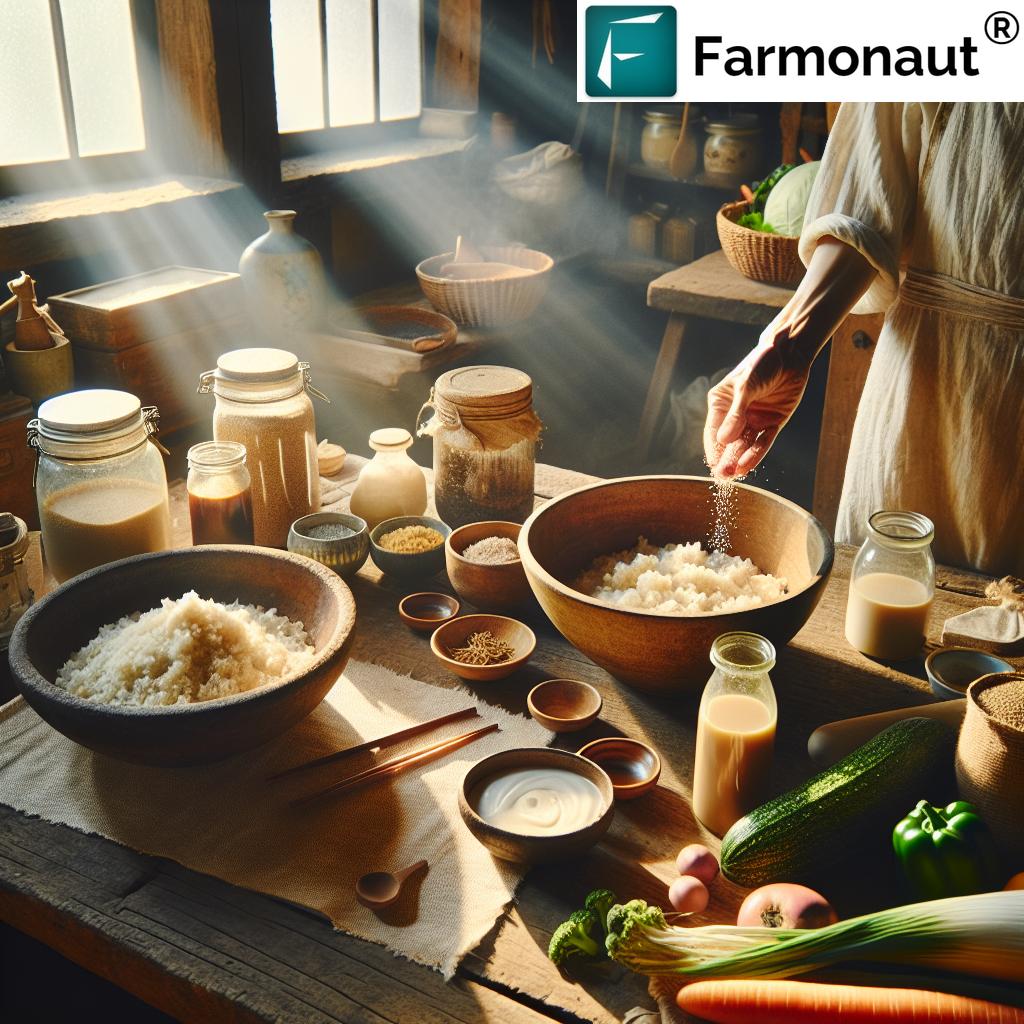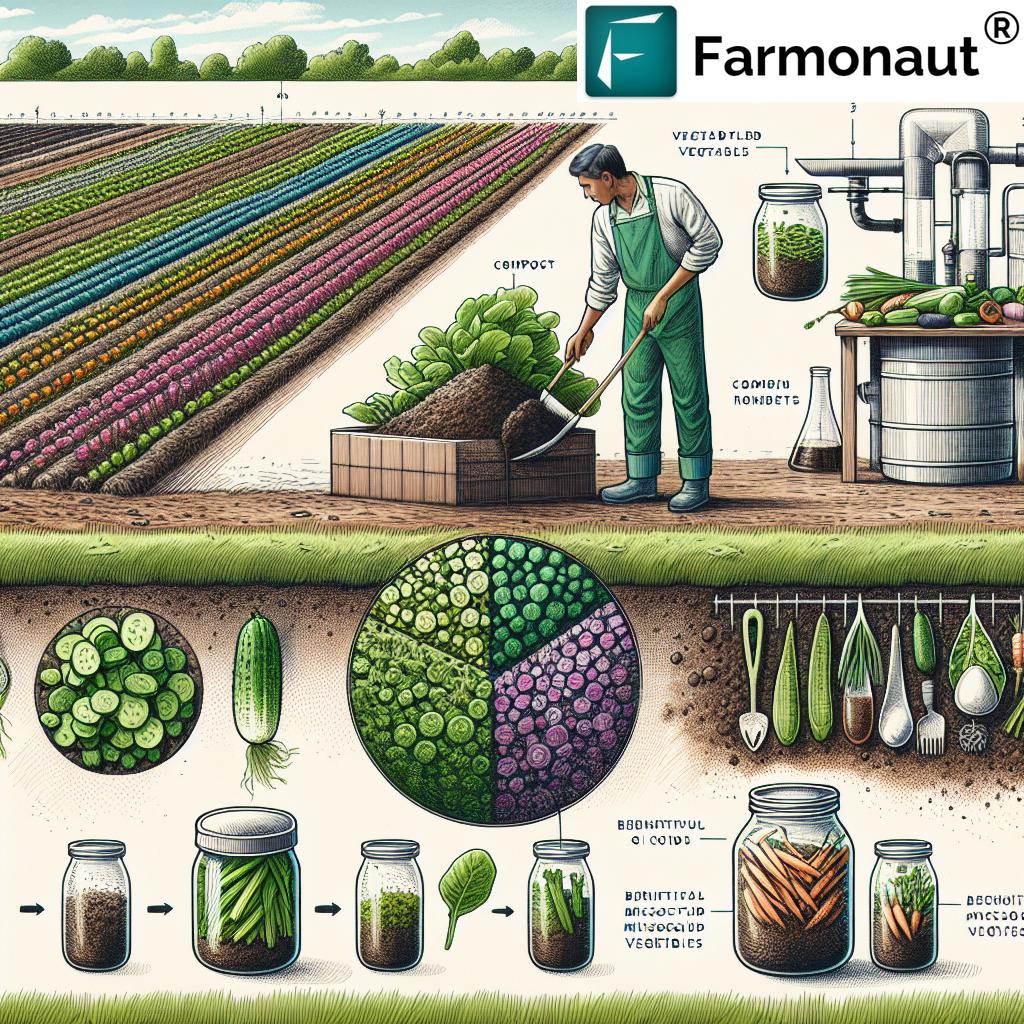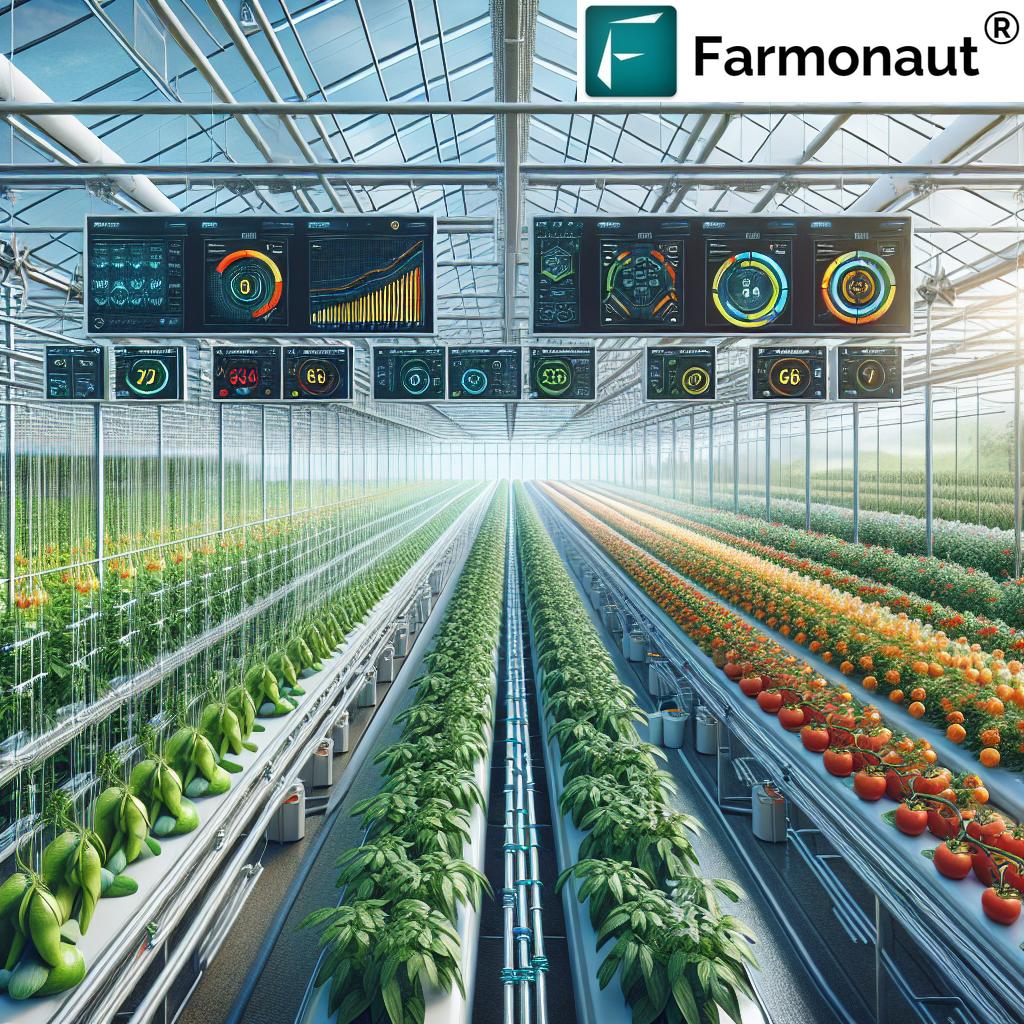Unlock the Power of Shio Koji: A Delicious Journey into Japanese Fermentation and Sustainable Cooking

“Shio koji can reduce marination time by up to 50% while enhancing flavors and tenderizing meats and vegetables.“
Welcome to a flavorful journey into the world of shio koji, a Japanese fermentation technique that’s revolutionizing farm-to-table cooking. We’re excited to explore this versatile marinade that not only enhances flavors but also promotes gut health and sustainable farming practices. Join us as we delve into the magic of shio koji and discover how it can transform your culinary adventures.
What is Shio Koji?
Shio koji, which translates to “salted koji” in Japanese, is a traditional fermentation starter that has been used for centuries in Asian cuisine. It’s made from a simple combination of koji (a type of cultured rice), salt, and water. This humble mixture packs a powerful punch when it comes to enhancing flavors and tenderizing foods.
The magic of shio koji lies in its enzymatic activity. As the mixture ferments, it produces enzymes that break down proteins and starches, resulting in enhanced umami flavors and improved texture in a wide variety of foods. It’s no wonder that shio koji has become a secret weapon in many professional kitchens around the world.
The Science Behind Shio Koji
To truly appreciate the power of shio koji, it’s essential to understand the science behind it. The fermentation process involves beneficial microorganisms, primarily the Aspergillus oryzae mold, which is responsible for breaking down complex molecules into simpler, more flavorful compounds.
- Enzymatic Action: Shio koji is rich in enzymes like amylase and protease, which break down carbohydrates and proteins, respectively.
- Umami Boost: The fermentation process creates glutamic acid, a key component of umami flavor.
- Tenderizing Effect: The enzymes in shio koji help break down tough muscle fibers in meats, resulting in more tender dishes.
This natural process not only enhances flavor but also increases the bioavailability of nutrients, making shio koji a healthful addition to your cooking repertoire.
Making Shio Koji at Home
One of the beauties of shio koji is that it’s surprisingly easy to make at home. Here’s a simple shio koji recipe to get you started:
- Mix 200g of koji rice with 60g of salt and 200ml of water in a clean glass jar.
- Stir the mixture well, ensuring all the koji is moistened.
- Cover the jar with a clean cloth or paper towel secured with a rubber band.
- Let the mixture ferment at room temperature (around 20-25°C or 68-77°F) for 7-10 days, stirring daily.
- After fermentation, your shio koji is ready to use! Store it in the refrigerator for up to 6 months.
Remember, the key to successful fermentation is cleanliness and patience. Your homemade shio koji will reward you with incredible flavors and versatility in the kitchen.
Culinary Uses of Shio Koji
The versatility of shio koji in the kitchen is truly remarkable. Here are some exciting ways to incorporate this fermented powerhouse into your cooking:
- Marinade for Meats: Use shio koji to tenderize and flavor meats like chicken, beef, or pork. The enzymes break down tough proteins, resulting in incredibly tender and flavorful dishes.
- Vegetable Enhancer: Toss vegetables with shio koji before roasting or grilling to bring out their natural sweetness and umami.
- Sauce Booster: Add a spoonful to soups, stews, or sauces for an instant flavor upgrade.
- Pickling Agent: Use shio koji in your pickling recipes for an extra layer of complexity and probiotic benefits.
- Bread Making: Incorporate a small amount into your bread dough for improved texture and flavor.
The possibilities are endless, and we encourage you to experiment with shio koji in your favorite recipes. You’ll be amazed at how it can elevate even the simplest dishes.
Health Benefits of Fermented Foods
“Fermented foods like shio koji can increase the bioavailability of nutrients by up to 50% compared to non-fermented counterparts.“
Incorporating fermented foods like shio koji into your diet can have numerous health benefits. Here’s why you should consider adding more fermented foods to your meals:
- Improved Gut Health: Fermented foods are rich in probiotics, which support a healthy gut microbiome.
- Enhanced Nutrient Absorption: The fermentation process can make nutrients more bioavailable, allowing your body to absorb them more easily.
- Boosted Immune System: A healthy gut microbiome is closely linked to a strong immune system.
- Potential Anti-inflammatory Effects: Some studies suggest that fermented foods may help reduce inflammation in the body.
By incorporating shio koji and other fermented foods into your diet, you’re not just enhancing flavors – you’re also supporting your overall health and well-being.
Sustainable Cooking with Shio Koji
In addition to its culinary and health benefits, shio koji aligns perfectly with sustainable cooking practices. Here’s how this fermented wonder supports eco-friendly food preparation:
- Food Preservation: Fermentation is an ancient method of food preservation that reduces waste and extends the shelf life of ingredients.
- Reduced Need for Additives: The natural flavor-enhancing properties of shio koji can reduce the need for artificial flavor enhancers and preservatives.
- Energy-Efficient Cooking: Using shio koji as a marinade can reduce cooking times, thereby saving energy in the kitchen.
- Support for Local Farming: Embracing fermentation techniques like shio koji can encourage the use of locally grown produce and support sustainable farming practices.
By incorporating shio koji into your cooking routine, you’re not just creating delicious meals – you’re also contributing to a more sustainable food system.
Shio Koji and Sustainable Farming
The connection between shio koji and sustainable farming practices runs deeper than you might think. As we explore the world of fermentation, it’s important to consider the agricultural practices that support these traditional techniques.
Organic, no-till agriculture is a farming method that aligns perfectly with the principles of fermentation and sustainable food production. This approach focuses on maintaining soil health, reducing erosion, and promoting biodiversity – all of which contribute to a healthier, more sustainable food system.
Here’s how organic, no-till farming supports the production of high-quality ingredients for fermentation:
- Soil Health: By avoiding tilling and using cover crops, no-till farming preserves soil structure and promotes beneficial microorganisms – the same kind that make fermentation possible.
- Reduced Chemical Use: Organic farming practices rely on natural pest control methods, resulting in produce that’s free from harmful pesticides and better suited for fermentation.
- Water Conservation: No-till farming helps retain soil moisture, reducing the need for irrigation and conserving water resources.
- Carbon Sequestration: Healthy soil can act as a carbon sink, helping to mitigate climate change – a crucial factor in ensuring the long-term sustainability of our food systems.
By supporting farmers who practice organic, no-till agriculture, we’re not only ensuring a supply of high-quality ingredients for our fermentation projects but also contributing to a more sustainable and resilient food system.
Shio Koji in the Context of Japanese Cuisine
To fully appreciate shio koji, it’s essential to understand its place in Japanese culinary tradition. This fermented seasoning is part of a long history of fermentation in Japanese cuisine, which includes other well-known products like miso, soy sauce, and sake.
In Japanese cooking, shio koji is valued for its ability to enhance the natural flavors of ingredients without overpowering them. This aligns with the Japanese culinary philosophy of highlighting the inherent qualities of each component in a dish.
Some traditional Japanese uses of shio koji include:
- Tsukemono: Japanese pickles made by fermenting vegetables with shio koji.
- Marinated Fish: Shio koji is often used to marinate fish, enhancing its flavor and creating a tender texture.
- Miso Base: Some artisanal miso producers use shio koji as a starter for their miso fermentation process.
By incorporating shio koji into your cooking, you’re not just adopting a trendy ingredient – you’re connecting with centuries of Japanese culinary wisdom and tradition.

Shio Koji and Modern Gastronomy
While shio koji has deep roots in traditional Japanese cuisine, it has also found its place in modern gastronomy. Chefs around the world are discovering the transformative power of this fermented seasoning and incorporating it into innovative dishes.
Here are some ways that shio koji is being used in contemporary kitchens:
- Molecular Gastronomy: Some chefs are exploring the enzymatic properties of shio koji to create unique textures and flavors in avant-garde cuisine.
- Fusion Cuisine: Shio koji is being used to add depth and umami to dishes from various culinary traditions, creating exciting flavor fusions.
- Plant-Based Cooking: Vegetarian and vegan chefs are using shio koji to enhance the flavors of plant-based proteins and vegetables, creating satisfying meat alternatives.
- Craft Brewing: Some innovative brewers are experimenting with shio koji in beer production, adding complexity to their brews.
The versatility of shio koji makes it a valuable tool in the modern chef’s arsenal, allowing for creative flavor combinations and techniques that push the boundaries of traditional cooking.
Shio Koji and Food Waste Reduction
In our quest for more sustainable cooking practices, it’s crucial to address the issue of food waste. Shio koji can play a significant role in reducing waste in the kitchen. Here’s how:
- Preservation: By using shio koji to ferment vegetables, you can extend their shelf life and reduce the likelihood of spoilage.
- Flavor Enhancement: Shio koji can breathe new life into ingredients that might otherwise be discarded, such as vegetable trimmings or slightly wilted produce.
- Whole Ingredient Usage: The umami-boosting properties of shio koji can help you create delicious dishes using parts of ingredients that might typically be thrown away, such as vegetable stems or meat offcuts.
- Batch Cooking: Shio koji-marinated dishes often keep well, making them ideal for batch cooking and meal planning, which can help reduce overall food waste.
By incorporating shio koji into your cooking routine, you’re not just enhancing flavors – you’re also contributing to a more sustainable and waste-conscious approach to food preparation.
Shio Koji Uses and Benefits
| Culinary Use | Benefit | Sustainability Impact |
|---|---|---|
| Meat Marinade | Tenderizes and enhances flavor | Reduces need for artificial tenderizers |
| Vegetable Fermentation | Extends shelf life and boosts nutrition | Reduces food waste |
| Sauce Enhancement | Adds depth and umami | Reduces need for artificial flavor enhancers |
| Bread Making | Improves texture and flavor | Enhances nutritional value of baked goods |
| Pickling Agent | Creates probiotic-rich preserves | Supports traditional food preservation methods |
| Flavor Booster for Plant-Based Dishes | Enhances umami in vegetarian/vegan meals | Promotes plant-based eating, reducing environmental impact |
Building a Community Around Fermentation
One of the most exciting aspects of exploring shio koji and other fermentation techniques is the opportunity to connect with a community of like-minded food enthusiasts. Fermentation is not just a cooking method – it’s a way of life that brings people together through shared knowledge and experiences.
Here are some ways you can engage with the fermentation community:
- Local Workshops: Attend or host fermentation workshops in your community to share skills and knowledge.
- Online Forums: Join online communities dedicated to fermentation to exchange recipes, troubleshoot issues, and share successes.
- Fermentation Swaps: Organize events where people can trade their homemade fermented goods, including shio koji creations.
- Collaborative Projects: Partner with local farms or food producers to create unique fermented products using locally sourced ingredients.
By engaging with others who share your passion for fermentation, you’ll not only expand your culinary horizons but also contribute to a more connected and sustainable food community.
The Future of Fermentation and Sustainable Cooking
As we look to the future, it’s clear that fermentation techniques like shio koji will play an increasingly important role in sustainable cooking practices. The intersection of traditional wisdom and modern science is opening up new possibilities for creating delicious, nutritious, and environmentally friendly foods.
Here are some exciting developments to watch for:
- Innovative Fermentation Starters: Research into new microbial cultures could lead to even more diverse and beneficial fermented foods.
- Precision Fermentation: Advanced technology may allow for more controlled and customized fermentation processes, tailoring flavors and nutritional profiles to individual needs.
- Fermentation in Space: As we look towards long-term space travel, fermentation could play a crucial role in producing nutritious foods in space environments.
- Climate-Resilient Fermentation: As climate change affects agriculture, fermentation could become even more important as a means of preserving and enhancing available food resources.
By embracing fermentation techniques like shio koji, we’re not just connecting with our culinary past – we’re also paving the way for a more sustainable and flavorful future.
Conclusion: Embracing the Power of Shio Koji
As we’ve explored throughout this journey, shio koji is more than just a trendy ingredient – it’s a gateway to a world of flavor, health, and sustainability. By incorporating this ancient fermentation technique into our modern kitchens, we’re not only enhancing our culinary creations but also contributing to a more sustainable and connected food system.
Whether you’re a seasoned chef or a curious home cook, we encourage you to experiment with shio koji in your own kitchen. Start with simple marinades, explore vegetable fermentation, and let your creativity guide you to new and exciting culinary discoveries.
Remember, every time you use shio koji, you’re participating in a centuries-old tradition of fermentation, supporting sustainable farming practices, and joining a global community of food enthusiasts who are passionate about flavor, health, and the environment.
So, are you ready to unlock the power of shio koji in your kitchen? The journey of discovery awaits!
FAQs
- What is the shelf life of homemade shio koji?
Homemade shio koji, when stored properly in the refrigerator, can last up to 6 months. - Can I use shio koji in vegetarian or vegan cooking?
Absolutely! Shio koji is excellent for enhancing the flavors of plant-based dishes and can be used to marinate vegetables or boost umami in vegan sauces. - Is shio koji gluten-free?
Traditional shio koji made with rice koji is gluten-free. However, always check the ingredients if purchasing commercially prepared shio koji. - How does shio koji compare to regular salt in cooking?
Shio koji not only adds saltiness but also enhances umami flavors and tenderizes foods due to its enzymatic activity, making it more versatile than regular salt. - Can I use shio koji in baking?
Yes, shio koji can be used in small amounts in bread and pastry recipes to enhance flavor and improve texture.
Explore our API and API Developer Docs for more information on integrating our services.
Earn With Farmonaut: Affiliate Program
Earn 20% recurring commission with Farmonaut’s affiliate program by sharing your promo code and helping farmers save 10%. Onboard 10 Elite farmers monthly to earn a minimum of $148,000 annually—start now and grow your income!










